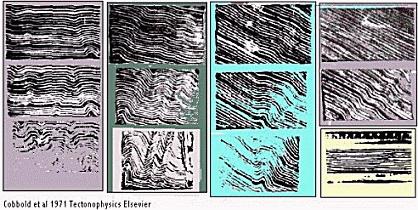
|
| ANISOTROPY
A rock usually deformed and metamorphosed with distinct planes, either discrete or nearly so. The response to applied stress on such a rock is different in different directions and depends on the shear as well as compression modulus which itself depends on the angle between applied stress and anisotropy planes and the degree of anisotropy. In contrast an isotropic material has the same modulii of shear and compression in all directions. The figure that accompanies this text is after Cobbold et al. 1971 who investigated experimentally Biot's theory of folding in laminated media. The interlayer slip and anisotroy are maximum to a layer parallel and layer normal shortening, but progressively decrease on applied stress changing its orientation from these two extreme situations. If the compression is layer parallel and interlayer slip not hampered, ideal conjugate kink bands are formed. If the interlayer slip gets hampered on account of lack of layer continuity or bounding material does not allow slip, the anisotropy is reduced and sinusoidal folds are formed in preference. If the compression applied is at angle to the layering, the anisotropy decreases (i.e. N and Q are not at variance but come pretty close to eachother so that their ratio is not too great), then single kink-bands are formed in preference to conjugate, other conditions having been met with. Under layer normal conditions, again the anisotropy is high and extensional kink-bands (normal) result as also other structures under low slip such as internal boudinage. The four sets of figures show how the anisotropy is under four idealised conditions chose by Cobbold, Cosgrove and Summers. |